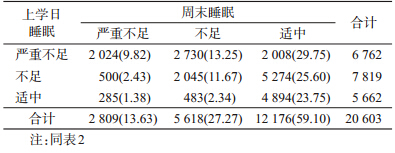文章信息
- 石文惠, 翟屹, 李伟荣, 沈冲, 施小明. 2014.
- Shi Wenhui, Zhai Yi, Li Weirong, Shen Chong, Shi Xiaoming. 2014.
- 中国8省(自治区、直辖市)儿童上学日与周末睡眠时间差异分析
- Difference on sleeping between school-days and weekends in elementary school children,data from 8 provinces in China
- 中华流行病学杂志, 2015, 36(6): 552-555
- Chinese Journal of Epidemiology, 2015, 36(6): 552-555
- http://dx.doi.org/10.3760/cma.j.issn.0254-6450.2015.06.003
-
文章历史
- 投稿日期:2014-12-07
2. 北京友谊医院统计室;
3. 南京医科大学公共卫生学院
2. Office of Statistics, Beijing Friendship Hospital;
3. School of Public Health Nanjing Medical University
睡眠状况和学生成绩、注意力显著相关[1, 2]。在以我国颁布的有关学生健康和工作卫生条例中规定的每天应保证小学生10 h睡眠时间标准的前提下,2005 年的调查研究显示,我国城市学龄儿童平时睡眠不足发生率高达71.4 %,平时睡眠时间越少、睡眠质量越差,学校总体表现就越差,学龄儿童在上课听讲和学习时的注意力越差;而周末睡眠时间则对其无显著影响[3, 4, 5]。然而我国普遍存在成年人和儿童周末补眠的现象。孩子周末睡眠过多,会影响生物钟的正常节律,导致周一持续疲劳,注意力难以集中[4],从而影响儿童学习。为掌握我国小学生周末睡眠的现状,本研究选取内蒙古、安徽、湖南、山东、甘肃、江西、广西、重庆8省(自治区、直辖市)儿童的调查资料,分析周末睡眠时间差异及其影响因素。 对象与方法
1. 研究对象:采取多阶段整群抽样的方法获得,详见文献[6]。本研究选取在体检日期时6~12岁且睡眠信息完整的27 727名儿童作为研究对象。所有研究对象均签署知情同意书。本研究通过中国疾病预防控制中心医学伦理审查委员会批准。
2. 调查内容和方法:采用自行设计的问卷,收集家长的一般情况,社会人口信息及学生性别、年龄、睡眠时间、起床时间等信息。体格测量包括儿童的身高、体重、腰围和血压。具体过程见翟屹等[7]的描述,通过家长会的形式,由培训的访问员组织家长统一填写问卷并回收。其中性别、年龄、BMI、睡眠时间等相关资料完整的问卷用于统计,最后得到有效问卷20 603份,回收率为80%。睡眠时间通过问卷询问、家长自报的方式获得。
3. 调查数据清理原则与判定标准:本研究按照国家规定以睡眠时间10 h为适量;按照国内外有关睡眠时间与健康关系研究[8, 9],将睡眠时间9~10 h视为不足,<9 h视为严重不足。6~12岁儿童超重、肥胖的分类参照文献[10, 11]。
4. 统计学分析:采用EpiData 3.0软件进行独立双人录入。用SPSS 17.0软件分析。以均数表示平均睡眠时间,睡眠严重不足、不足和适中以百分率表示;使用χ2检验进行组间睡眠构成比较。 结 果
1. 一般情况:共纳入城市、农村各24所小学20 603名学生,年龄6~12(8.7±1.8)岁。
2. 儿童上学日与周末睡眠时间睡眠现状:6~12岁儿童周末与上学日睡眠状态不同[6],周末平均睡眠时间为9.83 h,男生[(9.81±1.10)h]低于女生[(9.86±1.08)h],不同年龄别、不同性别儿童睡眠平均时间差异有统计学意义(年龄t=106.45,性别t=3.35,P<0.05)。男生周末睡眠时间多于上学日[6](t=75.06,P<0.05),随年龄增加,睡眠时间减少;女生周末睡眠时间多于上学日[6](t=75.70,P<0.05),未出现随年龄增加呈线性递减的趋势,趋势检验周末F=0.01,差异无统计学意义,见表 1。
经济好、中、差地区儿童平均睡眠时间分别为9.82、9.83和9.84 h;城市与农村儿童周末的平均睡眠时间为9.82 和9.83 h。不同经济水平地区和城乡儿童上学日和周末的平均睡眠时间差异无统计学意义。
3. 睡眠构成差异:小学生周末期间睡眠严重不足、不足和适中的比例分别为13.63%、27.27%和59.10%,不同年龄段小学生周末睡眠时间构成比差异有统计学意义(χ2=87.39,P<0.05);各年龄别儿童周末睡眠适中的比例(>50%)明显高于上学日比例(<30%);超过半数学生的睡眠时间达到国家规定标准,周末补眠现象明显;但6岁儿童周末依然有超过1/3睡眠时间不足10 h,12岁时比例升至40%;且上学日睡眠严重不足、不足和适中的儿童中,各自又出现一定比例的儿童在周末睡眠严重不足,见表 2,3。
周末全体儿童睡眠构成有所改善,睡眠严重不足、不足和适中的比例为13.63%、27.27%和59.10%,不同经济水平地区儿童睡眠构成差异无统计学意义。城市儿童的睡眠构成整体优于农村儿童,城市儿童睡眠严重不足的比例(12.81%)低于农村儿童(14.44%),睡眠适中的比例(59.42%)高于农村儿童(58.79%),差异有统计学意义(χ2=12.12,P<0.05)。
4. 上学日不同睡眠时间的儿童在周末的睡眠时间变化:上学日处于不同睡眠时间状态(严重不足、不足和适中)的儿童在周末的平均补眠时间上差异有统计学意义(F=1 017.13,P<0.05);上学日睡眠时间<9 h的儿童,其周末平均睡眠时间增加1 h以上;随着睡眠由严重不足到睡眠适中的改善,补眠时间减少,趋势检验:F=2 033.23,P<0.05,存在线性趋势。按照6~12岁儿童周末睡眠时间与上学日的不同,周末睡眠时间少于平时(>0.25 h)、与平时基本一致(±0.25 h)、适度补眠(0.2 h~1 h)和补眠过度(>1 h)比例分别为9.41%、22.77%、43.32%和24.50%,其对应的时间变化均值分别为-1.13、0、0.83和1.91 h。睡眠严重不足的学生中,补眠适度的比例为40.00%;而睡眠不足、适中的学生中补眠适度的比例分别54.00%和30.00%。睡眠适中的儿童中,周末睡眠时间少于平时的比例最高,接近20.00%;睡眠不足与严重不足的儿童中,周末少于上学日的比例为8.16%和3.45%。 讨 论
本研究显示,儿童周末补眠现象十分普遍,超过规定1 h的比例高达1/4。不少家长和孩子希望通过休息日一次性补眠来弥补平时睡眠的不足,而睡眠补偿并不能缓解由于平时睡眠不足导致的睡眠质量下降问题。睡眠时间不足本身就是睡眠障碍的一种表现,也是影响睡眠质量的关键因素之一,但补眠时间与睡眠时间并无明确关联[5],睡眠总体情况越差的孩子,周末就寝时间与起床时间均会推迟,对周末的睡眠时间长度虽说没有影响,但对作息习惯却有显著影响,由于就寝时间推迟引起入睡潜伏期延长,从而降低睡眠深度及质量[12];而且周末补睡越多,在客观注意力测试中的表现就越差,说明平时睡眠质量越差;试图利用增加睡眠时间来获得健康将适得其反。建议小学生周末补眠的时间不宜超过1 h。
本次调查发现6岁就有超过10%的儿童周末处于严重睡眠不足的状态,随着年龄增加,这部分人群的比例逐渐增大。而上学日尚未达到严重不足的儿童,在周末依旧出现睡眠时间严重不足的现象就更值得关注。美国“全国睡眠基金会”建议,青少年每天最佳睡眠时间21:45。密歇根大学研究,每天睡觉时间<9 h的儿童比睡眠时间更长的同年龄段儿童更可能变胖[13]。1998-2010年我国在新疆、四川、陕西、上海等9个省(直辖市、自治区)进行的30 250例不同年龄段儿童睡眠调研结果显示,超七成的中小学生睡眠不足;从全球范围看,我国学生的睡眠时间始终垫底,与美国、意大利、瑞士等国家同年龄段儿童相比,我国儿童学龄期平均每日睡眠时间约少40~50 min[14]。周芳[15]的研究也显示,慢性睡眠剥夺与儿童肥胖相关,而肥胖已经公认是影响青少年健康成长的独立危险因素。如果缺乏对睡眠时间的科学认识,随着儿童年龄增加、家庭作业日渐繁重、垃圾睡眠[16]现象及居室的环境影响、睡眠卫生习惯累积等影响,上学日睡眠时间不足将更加严重,而睡眠时间长期不足,不仅影响儿童长高,出现食欲下降,身体免疫力下降,导致近视眼等常见病;而且还会影响儿童思维活动、情绪等方面问题,成为健康的严重隐患。
我国在儿童睡眠研究领域的积累,大部分是基于横断面流行学调查的结果,很少有纵向研究的设计,已有研究也主要采用家长问卷进行回顾性调查,缺乏统一的问卷或量表,在界定相关调查时概念往往不完全一致,因此导致不同研究的可比性有待提高。因此,关注儿童睡眠状态,完善儿童的睡眠时间监测的方法,尽早进行儿童睡眠干预提供依据更是迫在眉睫。
| [1] Taras H,Potts-Datema W. Sleep and student performance at school[J]. J School Health,2005,75(7):248-254. |
| [2] O'Brien LM. The neurocognitive effects of sleep disruption in children and adolescents[J]. Child Adolesc Psychiatr Clin N Am,2009,18(4):813-823. |
| [3] Jiang YR, Chen WJ, Sun WQ, et al. School achievements in school-aged children with different sleep duration and quality [J]. Chin Mental Health J,2011,25(6):444-448. (in Chinese) 姜艳蕊,陈文娟,孙菀绮,等. 学龄儿童不同睡眠状况下的学业成绩表现[J]. 中国心理卫生杂志,2011,25(6):444-448. |
| [4] Sun WQ,Jiang YR,Chen WJ,et al. Influence of weekend catch- up sleep on sleep quality and academic achievements[J]. Chin J Child Health Care,2012,20(9):783-786. (in Chinese) 孙莞绮,姜艳蕊,陈文娟,等. 周末补偿睡眠对学龄儿童睡眠质量和学业表现的影响[J]. 中国儿童保健杂志,2012,20(9):783-786. |
| [5] Li SH,Shen XM,Jin XM,et al. Prevalence of daytime sleepiness and association with sleep behaviors,sleep environment in school-aged children of Shanghai city[J]. Chin J Child Health Care,2009,17(4):376-379. (in Chinese) 李生慧,沈晓明,金星明,等. 上海市学龄儿童“白天困倦”相关危险因素研究[J]. 中国儿童保健杂志,2009,17(4):376-379. |
| [6] Shi WH,Zhai Y,Li WR,et al. Analysis on sleep duration of 6-12 years old school children in school-day in 8 provinces,China[J]. Chin J Epidemiol,2015,36(5):450-454. (in Chinese) 石文惠,翟屹,李伟荣,等. 我国八省份6~12岁儿童上学日睡眠状况分析[J]. 中华流行病学杂志,2015,36(5):450-454. |
| [7] Zhai Y,Shen C,Li WR,et al. An epidemical survey of body mass index and obesity among 26 558 elementary school children in China[J]. Chin J Endocrinol Metab,2013,29(8):669-673. (in Chinese) 翟屹,沈冲,李伟荣,等. 我国26 558名学龄儿童体重指数及肥胖调查[J]. 中华内分泌代谢杂志,2013,29(8):669-673. |
| [8] Guo XF,Zheng LQ,Li Y,et al. Association between sleep duration and hypertension among Chinese children and adolescents[J]. Clin Cardiol,2011,34(12):774-781. |
| [9] Guan Y,Sun HY. The worry about the quality of adolescent health—based on the Investigation of the six largest city of children's way of life in China[J]. Youth Study,2004,12:9-15.(in Chinese) 关颖,孙宏燕. 青少年健康素质的隐忧——六大城市儿童生活方式调查[J]. 青年研究,2004,12:9-15. |
| [10] Li H, Zong XN, Ji CY,et al. Body mass index cut-offs for overweight and obesity in Chinese children and adolescents aged 2-18 years[J]. Chin J Epidemiol,2010,31(6):616-620. (in Chinese) 李辉,宗心南,季成叶,等. 中国2~18岁儿童青少年超重和肥胖筛查体重指数界值点的研究[J]. 中华流行病学杂志,2010,31(6):616-620. |
| [11] The Ministry of health disease prevention and Control Bureau of the people's Republic of China. The guidelines of the prevention and control for overweight and obesity in Chinese children and adolescents (Trial)[M]. Beijing:People's Medical Publishing House,2008. (in Chinese) 中华人民共和国卫生部疾病预防控制局. 中国学龄儿童青少年超重和肥胖预防控制指南(试用)[M]. 北京:人民卫生出版社,2008. |
| [12] Kohrman MH,Carney PR. Sleep-related disorders in neurologic disease during childhood [J]. Pediatr Neurol,2000,23(2):107-113. |
| [13] Carter PJ,Taylor BJ,Williams SM,et al. Longitudinal analysis of sleep in relation to BMI and body fat in children:the FLAME study[J]. BMJ,2011,342:d2712. |
| [14] Sun HY. Research report about the children's status of ten-year- development in China (1999-2010)[M]. Beijing:People's Daily Press Publishing House,2011. (in Chinese) 孙宏艳. 中国少年儿童十年发展状况研究报告(1999-2010)[M]. 北京:人民日报出版社,2011. |
| [15] Zhou F. The correlation between chronic sleep deprivation and childhood obesity[J]. J Wenzhou Med College,2011,41(2):187-190. (in Chinese) 周芳. 慢性睡眠剥夺与儿童肥胖的相关性[J]. 温州医学院学报,2011,41(2):187-190. |
| [16] Cai T. The Junk-sleep of children [J]. Health Manage,2012(4):86-87. (in Chinese) 菜头. 孩子的垃圾睡眠[J]. 健康管理,2012(4):86-87. |
 2015, Vol. 36
2015, Vol. 36





